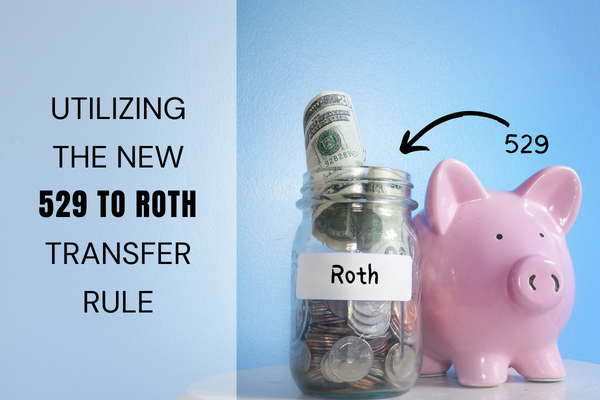Leaving Your Job? Don’t Forget Your Money!

Economic Update September 2019
September 27, 2019
Climbing the Latest Wall of Worry
November 12, 2019
By: Robert R. Shaw
After separating from an employer, there are essentially four ways to handle your vested interest in an employer-sponsored retirement savings plan such as a 401(k), 403(b), or 457(b). This article raises some points that you might want to consider. This is not a complete guide to the decision and should not be taken as investment advice.
Option 1: Cash Out
Taking a full distribution from your plan, often called cashing out, is the most extreme option and should only be considered if you have an immediate cash need and no other options. Once done, it cannot be undone.
Any distribution taken from a traditional (non-Roth) account will be included in your taxable income, which could even push you into a higher marginal tax bracket. In addition to income tax, distributions from both traditional and Roth accounts may be subject to an early withdrawal penalty. Penalties might not apply if the money is spent in certain ways, such as a first-time home purchase.
When you cash out your plan, you immediately lose the greatest benefit of a retirement plan – the opportunity for tax-deferred (traditional) or tax-free (Roth) growth. Because the growth compounds over time, that opportunity cost is higher the younger you are.
Option 2: Leave It Alone
Continuing as a participant in your existing plan is typically the default option and the easiest to execute. You simply do nothing. Many plans do have a minimum balance requirement. If your balance at the time of separation is below the minimum, it may automatically roll over to an IRA with the plan’s appointed trustee or be distributed directly to you.
Further contributions to your old plan are not allowed after you leave. That would not prevent you from contributing to a new employer’s plan, subject to its eligibility requirements. When starting a new job (or working two jobs simultaneously), it is possible to accidentally exceed IRS contribution limits. The limits apply per person across all plans of the same type.
Knowing exactly how much was contributed to your former employer’s plan earlier that year could help you decide how to set up contributions to your new employer’s plan and stay within the limits. Any employer contributions that may occur after separation, such as annual profit-sharing contributions, could factor in as well. Note that employer contributions for the current plan year may come as late as the due date, including extensions, of the employer’s federal tax return (think October of next year).
You will continue to deal with the plan sponsor, usually your former employer, and its chosen third parties (custodian, record keeper, administrator, etc.) under this option. It is wise to update them if you change your name, move to a new address, get married, get divorced, or want to change your plan beneficiaries.
If you choose this option, it could be worthwhile to revisit that decision periodically as your situation or the plan itself may evolve. As companies grow and shrink, change hands, and even go out of business, their plans often change as well. Over time they may replace the trustees, custodians, record keepers, or plan rules, not to mention fee structures and investment options.
Leaving your balance in place may be the best option today, but an adverse change to the plan or an improvement in one of your other options could alter the equation.
Option 3: Rollover to Another Plan
Door number three might open if you start a new job (or already have a second job), your new employer sponsors a retirement savings plan, you are eligible to participate in the plan, and the plan accepts roll-ins.
Even if roll-ins are allowed, you should compare fees, investment options, and plan rules before deciding. Plan rules may include whether and under what circumstances they allow in-service withdrawals, rollovers, Roth conversions, hardship distributions, or borrowing against your plan balance.
Ancillary benefits may also tip the scale. For example, some plans include free investment education, basic financial planning tools, and other benefits available to all participants regardless of account balance. As a plan participant, you are legally entitled to receive information about those features and more, so do not feel bad about asking the plan sponsor or administrator to provide it.
A separate question to ask yourself is whether you want your new employer to know how much or how little you’ve amassed. This is especially relevant in small and medium businesses. You may not want the person who decides your salary, bonus, or work assignments to know all about your savings.
Finally, note that exiting your old plan is a one-way street. Once you take assets away from the old plan, they cannot be put back.
Option 4: Rollover to an IRA
Options for rolling your plan balance to an IRA exist with nearly every bank, brokerage, and advisory firm. These run the gamut from online self-directed trading up to discretionary advisers who provide white-glove service. With infinite combinations of custodian, advisor, and fee arrangement as well as the broadest set of investment options, there is probably an IRA available that will meet your needs.
Whereas employer-sponsored plans typically have fees that are a flat percentage of account balance for all participants regardless of size, most IRA providers will have fee schedules that decline as balances increase. IRA fees may be negotiable, while plan fees typically are not. Further, many advisors base their fees on the total size of a relationship. If you already have other assets with a trusted advisor, you may achieve price breaks by consolidating all your investments under the umbrella of a single firm. If you’re already paying an advisor to help you manage investments inside the plan, weigh the total cost of the plan plus the advisor against the cost of converting it to a rollover IRA with that advisor.
If you are still working and accumulating your retirement savings, a possible advantage to an IRA is the opportunity to pay any management fees from outside the IRA. Paying those fees from a taxable account or simply writing a check would eliminate fee drag from the IRA and therefore maximize tax-advantaged growth. Every little bit helps.
If life doesn’t go according to plan, and you want to access some of your retirement savings earlier than expected, an IRA may offer more flexibility than an employer plan. Taxes and penalties may still apply, but with an IRA, the decision would be yours alone. A plan may require that you prove you are experiencing a financial hardship according to the plan’s definition or jump through other hoops.
Creditor protection is another issue to consider before rolling assets away from an employer plan. In the first place, creditor protection varies among plan types depending mostly on whether a plan is ERISA-qualified, such as a 401(k), or not, such as a 457(b). Further, the question of whether any creditor protection would follow to a rollover IRA depends on many factors. The answer hinges on state laws and is more complex than a simple yes or no. If this issue is important to you, you might consult an attorney with expertise in this area specific to the jurisdiction(s) in which you reside, own property, and do business.
Fees and Investment Options
IRA fees can take many forms. The IRA provider or advisor offering it should be able to clearly articulate how fees are calculated, when they are charged, and what payment options are accepted. Advisors also may offer to help you compare your plan options to their IRA options.
Employer-sponsored plans may have administration fees, platform fees, investment fees, individual service fees, or others. These may be annual, quarterly, monthly, or per transaction. A good first step is to search a full year’s statements for “fee” or “expense” and make a list. You might also ask the plan administrator to explain its fees, then compare that explanation to your statements and ask more questions if they don’t seem to agree.
Plans typically offer a few model portfolios, such as conservative, moderate, and aggressive. Some also offer a suite of target-date funds. Even self-directed plans that allow you to set your own asset allocation tend to be limited to a short list of funds chosen by the plan’s trustees. Generally, the larger the plan, the more likely these options are to be institutional share classes with low expense ratios.
With either a plan or an IRA, if you invest in mutual funds, your total fee calculation should include any sales loads, redemption fees, and ongoing management expense ratio. In a retail IRA or a plan’s retail brokerage window, fund expenses may be higher than similar funds in your plan menu. Some advisors offer cheaper share classes than you could access on a retail platform.
If your plan features a brokerage window, you can likely invest in almost any retail investment. Plans normally charge a fee for the privilege of accessing the brokerage window in addition to retail transaction fees. If buying mutual funds this way, your retail account may not qualify for the cheapest share classes. To compare this option to an IRA, add up the baseline plan fees, additional brokerage fees, and retail fund expenses. Compare that to the fees and fund expenses of your IRA options. Here again, the IRA providers or advisors you are interviewing should be able to estimate these costs for you.
Customer Service and Communication
Compared to IRAs, employer plans are more complex and have more key players. These include the plan sponsor (usually your employer), plan trustees (usually key executives of the employer), investment consultants, third-party administrator, and custodian. The landscape can be confusing and difficult to navigate when you want something. (Be ready to wait on hold and fill out some forms!)
By contrast, an IRA owner typically can deal directly with a custodian or a single trusted advisor for all needs. This factor may be important if you make a lot of changes or you are retired and living off distributions.
The quality and convenience of routine communications varies widely among plans and IRA options. In particular, the frequency and level of detail in statements or performance reports is all over the map. Other features to consider include websites or mobile apps for online account access, automated phone systems, and access to real humans by phone or in person.
Rollover Logistics
If you decide to roll your balance to a new employer-sponsored plan or to an IRA, the way in which that transaction is accomplished can have a big impact on the outcome. There are two pathways, direct (trustee-to-trustee) and indirect (trustee-to-you-to-trustee). Direct is almost always preferred.
This detail can meaningfully affect your taxes and your resulting account balance. An indirect rollover is sometimes referred to as a sixty-day rollover because that is the time allowed to redeposit the funds with the receiving trustee. Failure to deposit the funds within sixty days will result in the entire balance being treated as a distribution (see Option 1 above).
Even if an indirect rollover is properly executed, it’s possible to end up with less than your full balance in the new account. This is because the original plan may be required to withhold taxes from the check you receive. IRS rules allow you to deposit up to the full original plan balance with the new trustee, but you would have to come up with the difference (the amount withheld) from another source within the sixty days. Then you would have to wait until the following year’s tax refund to refill your other coffers.
Finally, note that if you make an indirect rollover, you must wait a full twelve months before doing another one. That time interval starts after completion of the first indirect rollover; it is not based on a simple calendar year. Failure of this test may result in the entire second event being treated as a distribution subject to taxes and penalties if applicable.
More than Math
Some of the above decision points are easily quantified. Fees, taxes, and penalties can be figured down to the penny. Doing the math is worthwhile, but subjective factors may ultimately drive your decision.
For example, sticking with a former employer’s plan may be undesirable if you left on bad terms or the Human Resources department is a painful bureaucracy. One plan may have cheaper funds but fewer fund options or more restrictive rules. You might just prefer the simplicity of rolling several old plans into your current employer’s plan so you can manage it all in one place.
It may be impossible to make a perfect decision but thinking through your options is a good start.
Robert R. Shaw is an investment consultant in Charlotte, NC. Robert creates tailored investment portfolios for institutions and wealthy families together with comprehensive plans for lasting financial success. Click here to learn more about Robert and how he can help you.
Carolinas Investment Consulting is not affiliated with any of the websites linked in this commentary. Nothing contained herein constitutes financial, legal, tax, or other advice. The views and opinions expressed in this article are those of the author and do not necessarily reflect the official policy or position of Carolinas Investment Consulting. The information published herein is provided for informational purposes only, and does not constitute an offer, solicitation or recommendation to sell or an offer to buy securities, investment products or investment advisory services. All information, views, opinions and estimates are subject to change or correction without notice. The appropriateness of an investment or strategy will depend on an investor’s circumstances and objectives. These opinions may not fit to your financial status, risk and return preferences. Past performance is not indicative of future returns.



